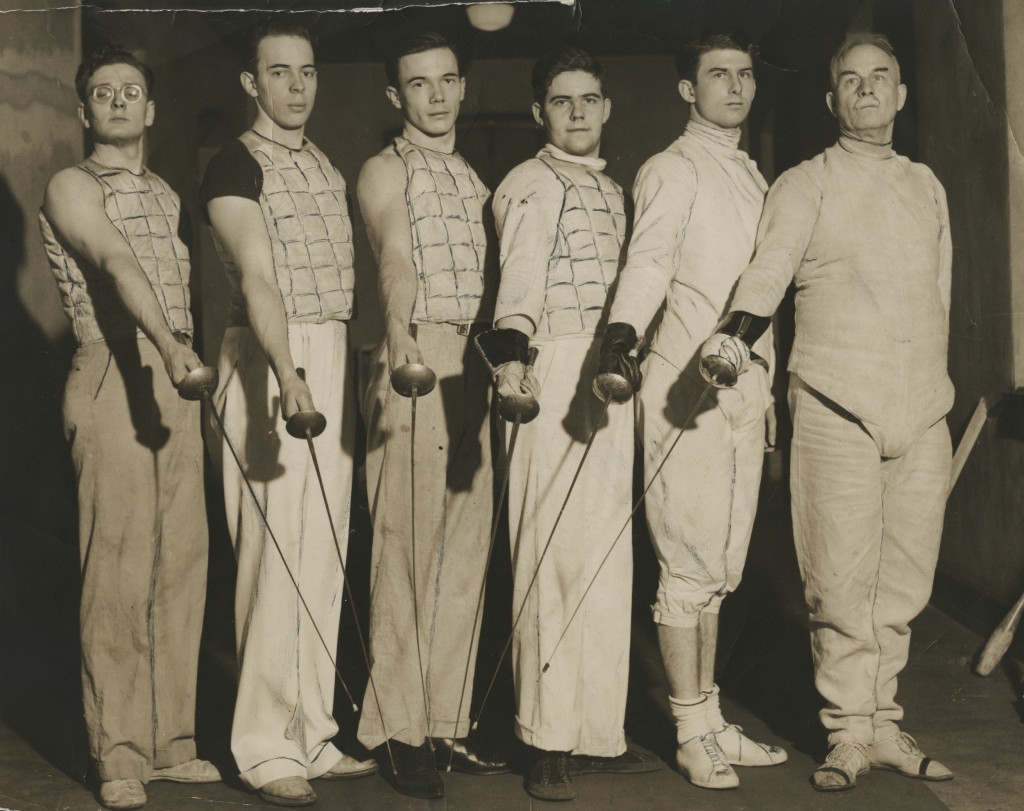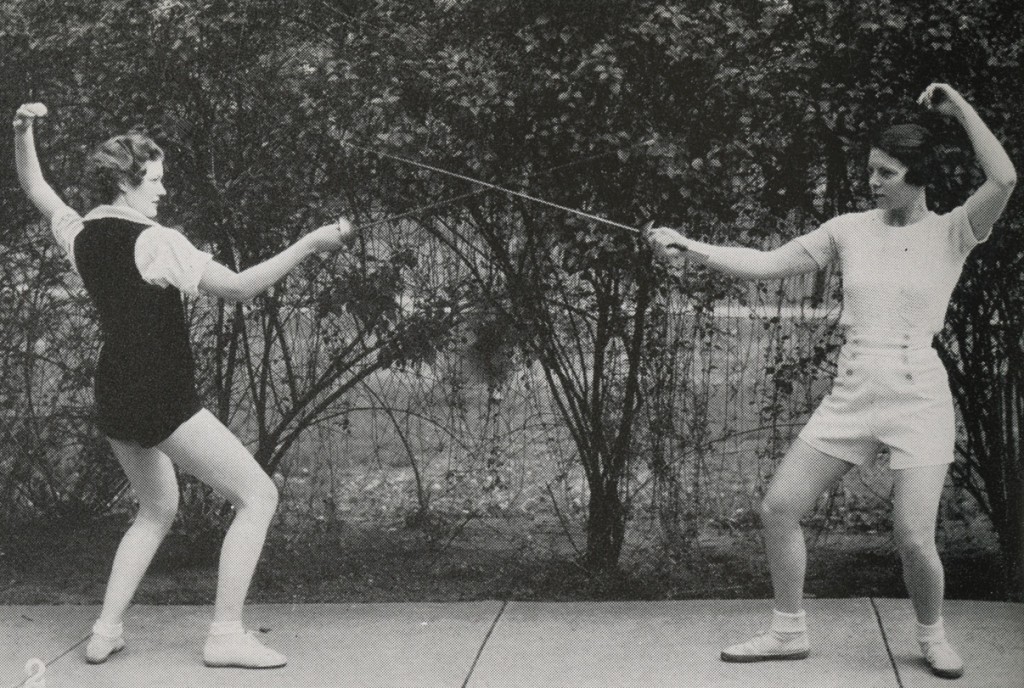By Richard G. Stearns

Fencing has always had few spectators and only a few participants. Yet it has a proud history and continues as a club sport at Vanderbilt after 78 years. Professor Herbert Sanborn got it started in 1934, coached it to a Southeastern Conference Championship by 1941, and continued coaching until 1957, 15 years after his retirement. The glory years were 1940–42 when the team was SEC Champion and 40 or 50 young women and men competed in intramurals.
THE SPORT OF FENCING
Simply put, fencing is combat with hand-held edged and pointed weapons. Egerton Castle, a Victorian-era author and fencing expert, placed the beginning of the “Art” at the time when guns made armor obsolete, so a weapon (or two weapons, one in each hand) had to be used for both offense and defense.
The sport is governed by international rules, and during matches, a foil bout is won by the fencer who first makes five “touches.” Sanborn only taught and allowed foil, which is a light weapon always intended for sport, not for combat.
Intercollegiate matches are between teams of three or four fencers. They have a round robin of individual bouts: So for a team of three there are nine bouts, and for a team of four there are 16 bouts. Vanderbilt’s squads have comprised from four to seven—three or four fencers on the first team and one to four substitutes.
FENCING’S CHIEF PROPONENT
Herbert C. Sanborn, a philosophy professor at Vanderbilt during 1911–42, originated, taught, and coached fencing at the university. He had earlier coached the Vanderbilt baseball team during 1912–13.
Sanborn was a lifelong athlete. As a student at Boston University, he ran track, pitched baseball for four years, and played right tackle during 1893–96. A year later he pitched and played tackle at Tufts University. Sanborn was offered a professional baseball contract in 1897, but chose instead to go abroad for his Ph.D. Students then were able to go from school to school for particular classes, taking final exams where they were awarded degrees. During an eight-year period, Sanborn attended at least five universities, from Heidelberg to Munich. At least one was inFrancewhere he learned foil fencing.
Called “Cocky” by his fellow professors, Sanborn was interesting in many ways, not only as an athlete. He often disagreed with Chancellor James Kirkland; for example, he came out for Germany on the eve of World War I.
Even before the advent of Sanborn, students are said to have fenced at Vanderbilt. Fencing classes began at the “Y gyms” in 1934, continuing with an exhibition and an intramural tournament the following year and men’s varsity with an intercollegiate match in 1936.
The Vanderbilt Hustler reported on the front page of the Jan. 5, 1934 edition: “Dr. Herbert C. Sanborn, white haired professor of Philosophy at Vanderbilt and one of the most learned men on the faculty, is responsible for a recent innovation in the University gymnasium curriculum … through a class in fencing, thought to be the only one of its kind in any Southern college. … A number of enthusiasts have already turned out. … Equipment … furnished by the ‘Y’ and any Vanderbilt student may enroll in the fencing classes at any time.”
In May 1934 the Hustler reports, “A part of the Vanderbilt fencing class … gave an exhibition match before the students of Isaac Litton High School. … Sanborn lectured on fencing technique, then the class paired off and went through a routine … to show good fencing form. Following this free play was allowed. … Annette Rothstein is … the only member of the girls’ class who is proficient enough to perform in public, but others are improving rapidly.”
In 1935 fencing was moved to old Kissam Hall (then a dormitory for men), apparently from the “Y.” Intramural fencing began in the winter and spring of 1935. In January the Hustler reported, “An intramural fencing tournament has been added … for both men and women.” On May 3, 1935, we read, “The match will include meetings between both boys and girls. … To top the whole affair, an exhibition match . … Sanborn will meet Mr. Metcalf of the Vanderbilt Medical Department.”
For the March 1936 intramural we read that “Chandler King has been seeded No. 1 with Melzer, Van de Voort, and Scott following in the order named. Sixteen men are entered. … Doris Busby, last year’s champion, is seeded No. 1 in the women’s division. … Annette Rothstein and Lillian McLaurin are expected to offer her the most competition. Busby and Rothstein drew first round byes. … McLaurin vs. Hyman and Lerman vs. Shore in first round matches.” The aforementioned Shore is Fannye Rose (Dinah) Shore, BA’38, who would later gain fame as a singer and television star.
Chandler King won against 16 men, and Annette Rothstein, BA’36, won against eight women.
On April 20, 1936, the first recorded intercollegiate match was a 7–2 loss to the University of Cincinnati. Two other matches are reported—Georgia Tech and Alabama. The scores are unknown, but Vanderbilt won at least one of these.
The following year, The Vanderbilt Alumnus reported that “the fencing team has already produced one coach, Captain John Melzer, coach of fencing at Castle Heights, who finished here last year.” He was good at it because Castle Heights became the “Southern Preparatory Fencing” champions of 1938. In 1936 Melzer was a graduate student in Vanderbilt’s Philosophy Department, returning temporarily from a residency at Yale.
Intramurals continued in conjunction with varsity training. In the Hustler on Dec. 10, 1937, we read, “Vanderbilt three years ago entered the inter-collegiate field. This does not mean that intramural fencing has been done away with. Classes are held in conjunction with the varsity team for beginners. Separate classes are held for girls.”
No matches were recorded during 1938–39. The Hustler on Feb. 2, 1940, reported that “… fencers return to intercollegiate competition next week for the first time in two years. … Not since the South’s best fencer Steed Rollins was Vanderbilt’s No. 1 man have the Commodores scheduled conference foes.” The 1939 Commodore included only a small picture of Sanborn with three unidentified students. Intramurals continued with a tournament on May 12, 1939. There is no mention of women competing.
Fencing revived during the 1939–40 season with a season warm-up against Castle Heights, won by Vanderbilt, and a five-match conference schedule that included two contests with Georgia Tech and Kentucky, and one with Georgia. The absence of a match with Alabama indicates that the school may have given up fencing in 1938 or 1939. This begins a continual loss of SEC fencing teams. In a YMCA-hosted fencing tournament in March 1940, Vanderbilt finished a disappointing third out of four.

SEC CHAMPIONS
The next year, Vanderbilt became SEC champions. They were featured on both the January 1941 Vanderbilt Alumnus cover and in a full spread in the 1941 Commodore.
“With Jack Farringer, student assistant, in charge, there are about 20 boys practicing regularly,” reported the Hustler.
Women also fenced that year. “New interest in fencing is being created under the new regime headed by Mildred Stahlman and Jack Farringer. The girls team is composed of 23 girls,” noted the Hustler.
Vanderbilt’s fencing team reigned as SEC champions again during the 1941–42 season. By then, however, there was no match with Georgia and the universities that supported SEC fencing had dwindled to three—Georgia Tech, Kentucky and Vanderbilt.
Professor Sanborn, coach of the fencing team, retired as professor at the end of the 1941–42 academic year, apparently retiring as coach as well in June 1942.
At that time his fencing prowess was undiminished, according to the Louisville Courier Journal: “… at age 69, Dr. H.C. Sanborn can whip the best members of his Vanderbilt University fencing team …[and] he remarked … I plan to die with my foils on.”
Commodore fencing practice continued through 1942, but there are no further references on fencing in the Hustler and none in the Commodore. Despite the war, it seems that there were students to fence—but without Dr. Sanborn to coach it, fencing as a varsity sport at Vanderbilt ended.
Two of the Vanderbilt fencers from those years, Lawrence Goldsby and Robert Springer, were both lost in World War II.
Perhaps, however, teaching Vanderbilt students to fence had a hand in helping the war effort. In a letter to Russell, Sanborn wrote: “During the late war some magazine whose name I have forgotten printed a picture of a Mr. Hardin who was the champion bayonet man of the army. … Hardin claimed his skill with the bayonet was due to his training at Vanderbilt in fencing.” The only student with the last name “Hardin” in any Commodore from 1939–42 is Richard Hardin of Birmingham, Ala, a freshman in 1939.
Sanborn himself returned to coach Vanderbilt fencing in 1947 and continued to be a competitive fencer. As late as 1954, the Vanderbilt Hustler records that he fenced in the Kentucky Open Tournament. He was then 81 years old. Having dropped a fence post on his toe, he could not move back and forth as fast as students, but if one came within reach he could parry the blade and skewer him instantly. He continued to fence until Vanderbilt fencing ended in 1957. He continued to exercise with a rowing machine to at least age 90.
Today the sport of fencing attracts a small number of students, who compete under the auspices of the Vanderbilt University Fencing Club. The club hosts three tournaments a year and travels annually to the Junior Olympic Championships and the Crescent City Open in New Orleans.
Richard Stearns, AB’48, MS’49, was a varsity fencer at Vanderbilt University during 1947–49 and assistant fencing coach during 1954–57. When he joined the faculty in 1961 he helped start fencing as a coed club sport. He retired as professor of geology, emeritus, in 1997. He may be reached at dick.stearns@vanderbilt.edu.
Read a more detailed version of this story, including references and footnotes.
DATA SOURCES AND ACKNOWLEDGEMENTS
Information comes mainly from Vanderbilt Special Collections and University Archives. They house the yearbooks, microfilms of the student newspaper, and the Herbert Sanborn archive. Nashville Public Library houses microfilms and clippings of the Nashville Banner and Tennessean. The writer is grateful for the patience and help of the archivists and librarians.
This report is subject to errors of omission. Not all students submit their picture and activities to the yearbook. Also, the writer likely missed something during tedious viewing of microfilms of the Vanderbilt Hustler and city newspapers.